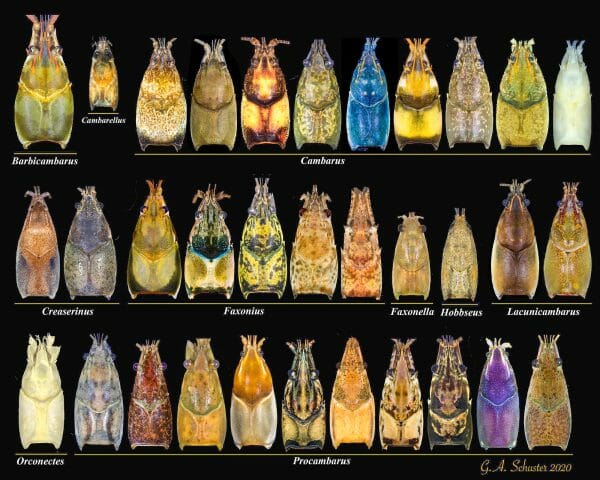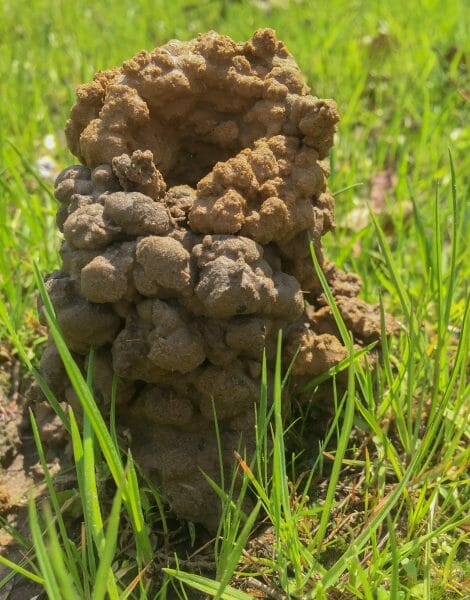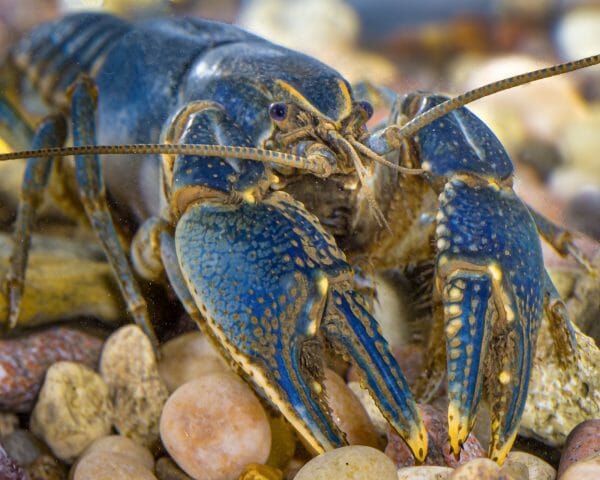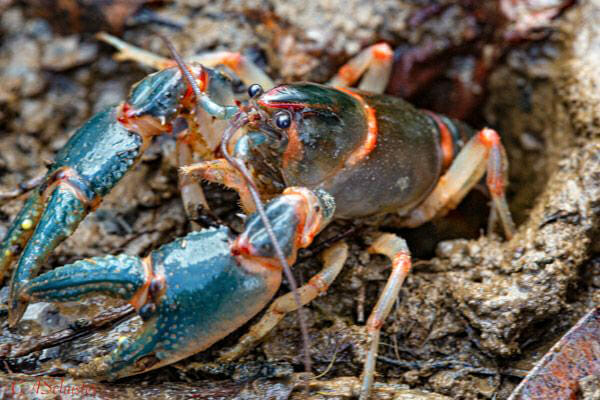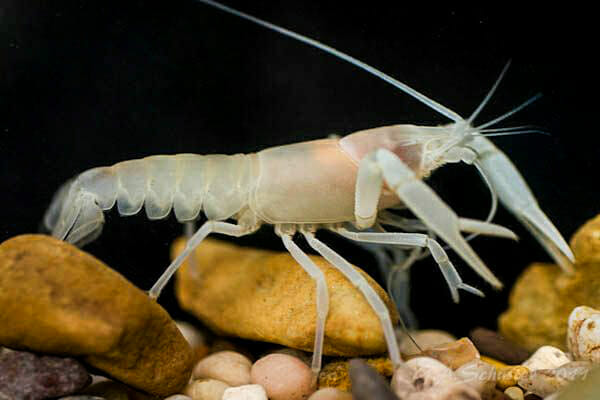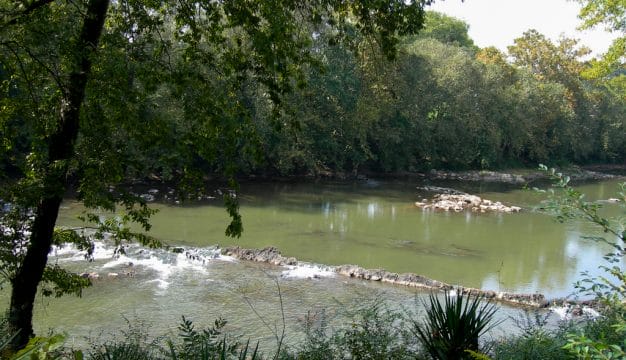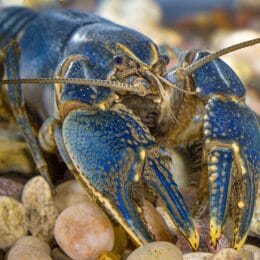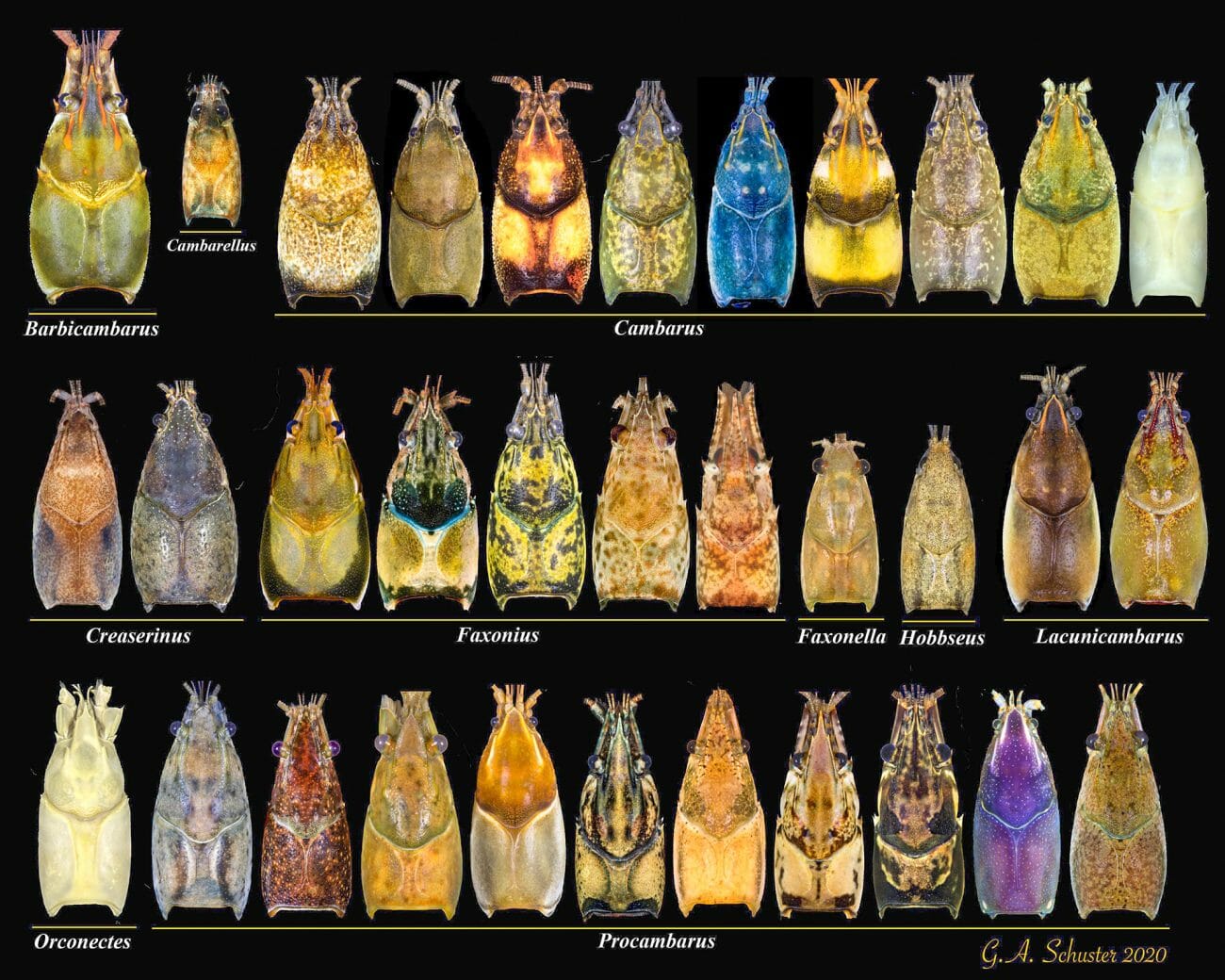Crayfishes of Alabama
Alabama is notable among U.S. states for its biodiversity, and freshwater fauna, including crayfish, are a significant part of that biodiversity. Whether one refers to them as crayfish, crawfish, crawdads, mudbugs, or some other local name, these crustaceans can be found throughout the state. They feed on practically anything, including vegetation, live animals, and dead animal matter. Many animals, including fishes, insects, turtles, turkeys, raccoons, humans, and other crayfish, feed on them in return, making them a valuable link in the food web in many aquatic systems. They are popular for teaching children catch-and-release trapping practices, readily available bait for fishermen, and succulent table fare.
According to the latest tallies, there are more than 600 species found worldwide on five different continents. Only Africa and Antarctica lack crayfishes. Of those 600-plus species, 100 have been documented in Alabama since scientific collecting began in the mid-nineteenth century. But that list only includes species that are formally recognized in the scientific literature and whose presence is confirmed with specimens collected within the state. There are about 10 species from states adjacent to Alabama that may easily move back and forth, but their presence has not yet been confirmed in Alabama. Experts assume they likely will be found in the state with sufficient sampling effort, and they are referred to as "hypothetical species." There are also a few species that are very similar and may actually represent more than one species. Once those are examined and formally described, it is likely a few more species will be added to the list. There are also numerous under-sampled habitats in Alabama, including seasonal ponds, bogs, burrows, swamps, caves, large rivers, and reservoirs. More collecting in those habitats could yield more species. Taking into consideration the hypothetical species, the species complexes, and additional sampling, it is reasonable to assume there may be another 10 to 20 species of crayfishes in Alabama.
Crayfish Biology
Freshwater crayfishes are native to all continents except mainland Africa and Antarctica. They are in the Phylum Arthropoda (from the Greek for "jointed legs"), meaning they are invertebrates with an external skeleton, a segmented body, and paired appendages, and the Order Decapoda (from the Greek for "10 feet"), meaning they have five pairs of walking legs. They are further classified as crustaceans, with an exoskeleton made of chitin or chitin and calcium, appendages in pairs on each of three body segments (some modified for special purposes such as walking, grasping, and sexual reproduction), and two pairs of antennae. The crayfishes of Alabama all belong to the family Cambaridae. Crayfish relatives include barnacles, crabs, lobsters, shrimp, water fleas, and wood lice. They are gill breathers, with the gills located on the underside of the body.
The life cycle of crayfishes consists of egg, juvenile, and adult stages. Complex courtship prior to mating has been observed, with three stages: contact, the male turning the female, and mounting. Once the pair are close, they begin to flick their antennae at each other and the male grabs at the female. She initially resists, and this behavior may last for over an hour. When she ultimately accepts his advances, she becomes still, opens her appendages, and he turns her over and mounts her. The female stores sperm within her body for use when temperature and amount of daylight hours are optimal for fertilization. Upon fertilization, the eggs are attached to the underside of her body in a cluster resembling a bunch of berries, and thus she is said to be "in berry." The young hatch several weeks later and remain attached to the female until they undergo three molts, when they detach and strike out on their own. As with all crustaceans, crayfish molt throughout their lives, and juveniles will molt 11 times before reaching maturity, possibly within months.
Crayfish Ecology
As noted earlier, Alabama's remarkable diversity of habitats have enabled an equally diverse distribution of living things in the state. Alabama is blessed with a diverse geologic setting never marred by glaciers and an abundance of water resources. Six distinct geologic sections straddle the state, from the undulating hills of the Central Basin and Highland Rim in north Alabama, the rolling surface of the Cumberland Plateau and the rugged mountains of the Alabama Valley and Ridge in central Alabama, the hard, angled rocks of the Piedmont Upland in east Alabama, and the vast, rolling Coastal Plain of unconsolidated rocks that covers the lower two-thirds of the state. The unique properties of these geologic provinces and their long, sustained periods of development and decline provided a varied landscape and ample time for species to evolve.
Alabama's water resources are just as diverse as its geology. There are more than 133,000 miles of surface streams in Alabama, and all of them eventually flow into the Gulf of Mexico, but by somewhat different paths. Crayfish are important members of most aquatic communities and occupy a wide range of habitats. They are the largest group of invertebrates in these habitats and often represent the greatest invertebrate biomass. They are known to live in almost every available freshwater aquatic habitat, including caves, springs, small to large creeks, rivers, reservoirs, seasonal ponds, marshes, swamps, bogs, and ditches.
Many crayfish live in open-water habitats among logs, rocks, and vegetation, but some prefer to burrow near streambanks or in more isolated areas. Experts generally separate burrowing crayfish into two categories: primary and secondary. Primary burrowers spend most of their lives in burrows not connected to surface water, such as rivers and streams, but rather to water found below the ground’s surface. These burrows may be in low-lying fields or floodplains and can be relatively simple or very complex, ranging from approximately three feet (one meter) or less to more than 13 feet (four meters) deep, with multiple channels and openings. Burrows usually have an expanded chamber at or near the bottom where the crayfish live. The burrow may have a main entrance that is marked by a circular or horseshoe-shaped "chimney" consisting of mud in the form of pellets that have been removed from the burrow. These chimneys may reach 10 inches (25 centimeters or more) in height. Burrowers generally perform chimney building and other activities at night, and on rainy or humid nights may leave the burrow to search for food or mates.
Secondary burrowers are species that burrow along or near the edge of a stream. These burrows may be directly connected to the water by one or more channels, may have an enlarged chamber at or near the bottom, and like primary burrowers may have a chimney extending from the main channel of the complex. These burrows are often not as complicated as those of primary burrowers and these species, because of the connection with an adjacent body of water, may sometimes be found in the water body.
Tertiary burrowers typically live in permanent aquatic habitats such as rivers, streams, or ponds and burrow only when necessary for survival. They may excavate cavities under rocks or woody debris or dig shallow burrows when surface waters recede.
Of particular interest are the species that live in Alabama's abundant cave environments. Some live mostly in the dimly lit zone around cave mouths and may occasionally travel into the caves, but they are not completely adapted to cave life. They may have smaller eyes than species that never enter caves but have not lost their coloration. Other species are fully adapted to living in complete darkness in caves or aquifers and are known as stygobitic. They have evolved to develop entirely without eyes or have only rudimentary eyes represented by eye stalks and have lost their coloration and appear to be mostly white. Sometimes the internal organs can be seen through the translucent exoskeleton. These species have also evolved very long antennae to offset the loss of eyes. In Alabama, there are eight stygobitic species.
Distribution
Geologic and hydrologic barriers often dictate where crayfish species are found within Alabama, and perhaps the most significant feature is the Fall Line, an imaginary line where older rocks in the northern half of the state are overlain by the younger rocks of the East Gulf Coastal Plain. In Alabama, there are 45 species found almost exclusively above the Fall Line, 42 species found almost exclusively below the Fall Line, and only 13 species found both above and below the Fall Line, suggesting it is not a factor in their distributions. One genus, Barbicambarus, whose two members live exclusively under large slab rocks in streams with swiftly flowing water, is only found above the Fall Line where abundant rock formations and flowing water are common. Faxonella and Hobbseus, all largely if not exclusively composed of burrowing species, and Cambarellus, whose species are usually found in bogs and other wetlands, are restricted to the coastal plain, where they take advantage of the loose sediments and generally flat topography. The two members of the genus Orconectes found in Alabama are restricted to caves associated with limestone formations and are also restricted above the Fall Line in the cave-rich northern part of the state. Members of the four remaining genera known from Alabama are found both above and below the Fall Line, but each is found more abundantly in one or the other sections. The genus Cambarus is very diverse and largely made up of species that live in running water, but some species prefer still-water environments or are among the burrowing species. The genus Faxonius is a less-diverse group, and its members live in ponds, lakes, marshes, and bogs above the Fall Line. Members of the genera Cambarellus, Creaserinus, and Procambarus show just the opposite tendency. Many of their members tend to be riverine or burrowing species, although some are found in still-water environments. Members of all three genera are concentrated below the Fall Line.
Currently, there are 15 crayfish species that are endemic to (found only in) Alabama, with eight restricted to the Tennessee River system and seven to the Mobile River basin. The Tennessee River system is the most species-rich area in the state for most species of freshwater animals. To date, almost half the crayfish species in the state have been found in that system, despite it draining only 13 percent of the land area of the state. The Mobile River basin, which drains about 61 percent of the land area of the state, hosts 59 species, with 21 species restricted to that basin. The collective coastal plain drainages found to the east and south of Mobile Bay and the Mobile River basin drain about 22 percent of the land area of the state and host 29 species, with eight species restricted to those areas. Coastal plain tributaries in Alabama from Mobile Bay and the Mobile-Tensaw Delta west to and including Mississippi Sound tributaries drain four percent of the land area of the state and host 23 species, with three endemic species.
Among the eight cave-dwelling species found in Alabama, all occur in the cave-rich Tennessee River valley. Three of them are found in single caves and one in a small group of very closely spaced caves. The prickly cave crayfish (Cambarus hamulatus), a commonly encountered cave dweller, is also found in a few caves in the Mobile River basin. One hypothetical species is the Dougherty Plain Cave crayfish (Cambarus cryptodytes), so named for the region of that name found in southwest Georgia and southeast Alabama. The crayfish is found in caves and springs in the Crystal River aquifer in Georgia and Florida on either side of Alabama. With additional sampling, it will surely be found in Alabama someday.
Threats and Conservation
For about 17 years, staff from the Geological Survey of Alabama worked alongside crayfish experts Guenter A. Schuster of Eastern Kentucky University and Christopher A. Taylor of the Illinois Natural History Survey to learn more about crayfish populations in Alabama. The goals of the research were to determine what species occur in the state, where they occur, and what their respective conservation statuses are with the goal of providing guidance to the Alabama Department of Conservation and Natural Resources. A major outcome of the research is the book Crayfishes of Alabama, which was published by the University of Alabama Press in 2022. Ninety-nine species were described, as well as 11 hypothetical species. After the book's publication, one hypothetical species was confirmed when a specimen was found in a hayfield in Sumter County, bringing the state's species count to an even 100.
Concerns for the continued survival of crayfishes include the usual factors that affect other aquatic species, including pollution from industrial and municipal wastewater activities and more widespread runoff from agricultural and forestry practices. Habitat destruction and modification are also significant factors. They include destabilization of stream banks leading to bank failure and inundation of the stream bed by sediments, removal of existing tree canopy leading to changes in stream temperatures, modification of stream flows from mining endeavors, and barriers such as dams, docks, and poorly designed roads.
Perhaps the most significant threat to the native crayfish fauna is the introduction of non-native crayfish species that are more aggressive, larger, and able to reproduce more quickly than natives. These species are introduced from other parts of the country when they are sold as fish bait and dumped into local water bodies or when they are accidentally collected along with fish for stocking purposes and are transported to the state and released with the fish and become established. The most significant non-native crayfish in Alabama is the virile crayfish (Faxonius virilis), which was first discovered in the state in a cave along the Tennessee River in 1953. It is native to a wide area of central North America and has since spread across north and central Alabama in larger streams, suggesting it was introduced as bait. The other two invasive species were found more recently. The Kentucky River crayfish (Faxonius juvenilis) is native to the Ohio River system in Indiana and Ohio and the Cumberland River system in Kentucky. It was discovered in 2013 but only from a few locations in the Black Warrior and Coosa River systems. The gray-speckled crayfish (Faxonius palmeri palmeri) is native to the lower Mississippi River valley in Kentucky, Tennessee, Mississippi, and Louisiana. It was found in 2014 and, so far, is only known along the main channel and impounded reaches of the Coosa River upstream of H. Neely Henry Dam.
As the invasive species expand their ranges they will displace native species, perhaps leading to the need for increased state or federal protection for natives. Hopefully, no additional exotic species will become established if a method of stopping their introduction can be established either through voluntary means or through regulation of the fish stocking industry. State wildlife departments in other states are actively attempting to establish useful regulations. If the state can develop sound management practices and regulations, like those that have allowed other species to thrive, there is hope that Alabama's fabulous crayfish fauna will continue to flourish.
Further Reading
- Shelton-Nix, E., ed. Alabama Wildlife, Vol. 5. Tuscaloosa: University of Alabama Press, 2017.
- Schuster, G. A. "Review of Crayfish Color Patterns in the Family Cambaridae (Astacoidea), with Discussion of Their Possible Importance." Zootaxa 4755 (March 2020): 63-98.
- Schuster, G. A., C. A. Taylor, and S. W. McGregor. The Crayfishes of Alabama. Tuscaloosa: University of Alabama Press, 2022.
- Taylor, C. A., et al. "A Reassessment of the Conservation Status of Crayfishes of the United States and Canada after 10+ Years of Increased Awareness." Fisheries 32 (August 2007): 372-389.
